Tags
Chihayafuru is the most enjoying series that I’m following on this season. Aside from its interesting shoujo plot and adorable characters, as I watch Chihaya, I’m feeling the deep urge to learn and play competitive Karuta.
Come to think about it, almost every moves she does is an art according to its own right. Of course, body movement is a behavioural and cultural thing. However, as humans, the appreciation of these gestures is something that is, I believe, universal to all of us. As a sports fan, I always enjoy whenever a slow motion and intensified body action is being previewed. It is such a visual feast wherein every move is integrated and sensationalized as poetic and artistic.
Karuta is a Japanese card game. Basically, it’s played by being able to quickly identify which card out of an array of cards corresponds to the recited poem and then being able to snatch it before the opponent does. At the end of the game, the player who stole the most number of cards wins the competition.
I neither have knowledge nor experience on how this game is being played. That’s why as I follow Chihayafuru, I become fixated and eager to try this game. The more and more I pay attention, I realized that my desire to learn this game was actually brought the stylized gestures and agile movements of the characters.
Take for instance, I’m captivated by how the emotion filled noise overtakes the muteness of the room. The free flowing movements of the stretched and flexed arms are so engaging to look at. It’s like an abrupt shift that visually defies the friction in the air—which is embellished by the visible traces of the motion hanging in the vacant atmosphere. Also, I’m so impressed by how the body weight shifted accordingly with the swift movements of the shoulders and hands. Such actions look so stylistic, sporty and engaging.
Moreover, the hand movements are so entertaining to look at. I enjoy how the players’ hastily chase and tease each others’ hands; most especially, whenever they snap and break the silence on the room as they try to quickly snatch the card. In fact, the competitive feel of the scene commandingly hooks and shuts me up. In addition, I truly appreciate how the hands are being used to express emotions, for example the simple closed fist, and firmed and extended fingers openly convey the feelings and passion of the character.
Lastly and my most favourite part, the cards were grippingly thrown and flipped into the air. This creates an illusion which effectively stirs sensations and excitations. Often, I find myself silenced and looking so attentively as the card leisurely suspend and spin on the empty space as it eventually bounce and slide on the floor. For me, this scene creates an adrenalin pumping and literally breathtaking atmosphere due to the stillness of the scene.
Thus, as Chihayafuru shown, body movements are forms of language and art. We may not be noticing that much but we enjoy anime not just because of the plot and pretty faces of the characters, but also because of how these characters move and communicate with us. Body movements are lingos that help us grasp the story and internalize the characters. We must feel what is happening as much as we see it. With this, we’ll discover that our personal thoughts and own experiences will be submerged in the course of watching for this moment. Hence as an outcome, we’re becoming acutely sensitive and receptive to new world of information—or 2D world, as in the case of anime.


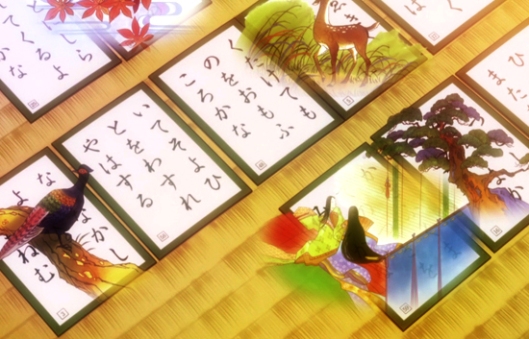





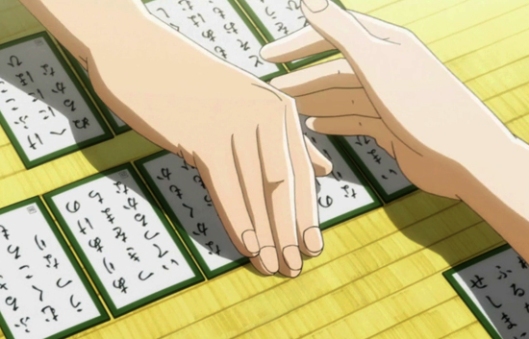

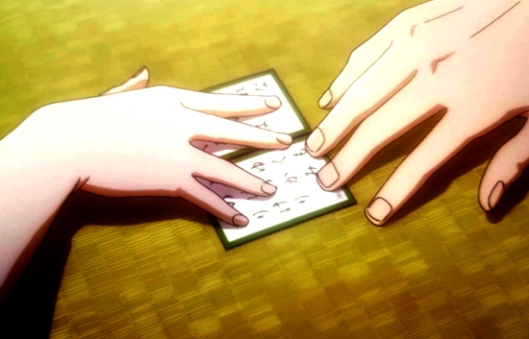

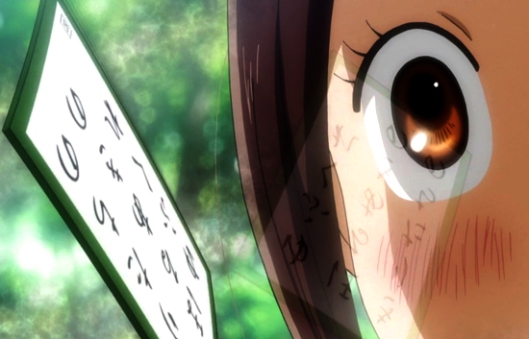


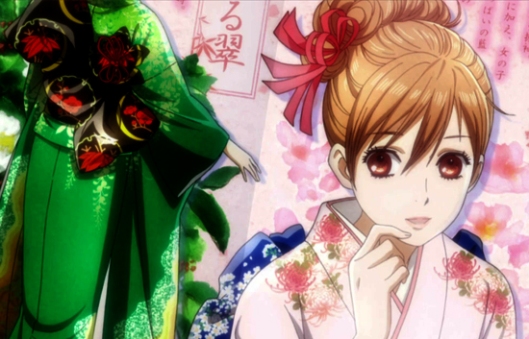
It’s basically the same way I felt watching Saki and a certain other show I’ll review very soon. Which one you ask? It’s a surprise but believe me, it’ll definitely be one worth your interest. It’s not the review coming up later today (Ninja Nonsense), it’s the one coming afterwards.
Back on topic, I like writing poetry, noted in my Poetry in Dismay page, but I’m not hardcore enough to master the art of recognizing verses in less than a second. Chihaya’s super hearing is most impressive and makes her matches 10 times more epic than Arata’s. I think its because it’s more exciting watching Chihaya play.
Which brings up the question, was there a Taichi match other than the one where he took on Arata, later Chihaya? I think most of the other matches he was in were team matches with Arata and Chihaya which didn’t exactly show us his special skills.
Something that will hold my interest… hmm, you’re keeping me in suspense.
Yeah, Chihaya’s super hearing ability is so impressive. Who would’ve thought that on a closed running train, considering the noise of the engine, she could still hear Arata? Like, wow.
I’m not too sure if there’s going to be a Taichi match. It’s already been showing that he plays with Chihaya but his special capabilities are never brought up. On the side note, Taichi would’ve been really adorable if he’s not being a jerk at time.
Woah, I love the art! :O
The only “game”-series I have been in contact with are Hikaru no Go and Yu-Gi-Oh, and the former is surprisingly fun. I don’t know how the anime is, but I recommend the manga. And after all, art by Takeshi Obata is always good stuff~
Thanks! I really hand-picked the photos. There’s quite a lot that I like to be included but the space is limited.
So you have read the manga… if you’re going to ask me, I highly recommend this show. I’m so in love with this series.
Body movements, eh? Something I’m so familiar with having done kung fu and signing ASL… ^_^
Chihayafuru is really quite visually stunning, and the animation is great. I’ve checked out some videos of karuta in real life, and it was pretty cool watching them in action:
Thank you for the link!
Looks really cool! But I guess as pretty as it looks like, it’s much better to wear shirt and pants instead of kimonos because the movement isn’t that too restrained.
Wow, this post says exactly what I feel about Chihayafuru. It’s just that I never think of body movement as a way to describe the excitement and thrills I get everytime a game is played. Great post!
My idea came from watching sports. I noticed that the sports news and channels always highlight the movements of the players, then I noticed that what exactly Chihayafuru does.
It’s great that this show can put so much energy into the game and those playing it without reaching that particular level of absurdity we know from a certain other show about cards. The characters take it seriously, and that’s made easy to understand.
I really like how the passion of the character being animated. It’s so well-done and not over to the top.
This is the most realistic card game anime I have ever seen. I love it.
Indeed, I so love this show too.
What more can I say? You managed to put in words the magic of the anime. When body language is used well in any visual medium, it adds beauty and meaning, Such cases are also Mawaru Penguindrum and Shoujo Kakumei Utena, as was first noticed by Wabisabi in Iwa ni Hana.
I get excited not only from the hands’ movements but also how the card flies into the air with speed. I love it even more when it bumps onto other objects like the window or the shoji screen (it stuck in there like a ninja star!).
And since you love karuta, here is a song you might know, if you’ve watched honey and clover, with an unexpected amv…
Thanks for the link Ayame. I’m not familiar with the song because I have yet to watch Honey and Clover.
Indeed, body movements offer a very stunning visual medium. And as you and Wabisabi said, Mawaru Penguindrum and Utena did such great job on sensationalizing the character to convey deep meaning and beauty. So fun to watch! But as for Chihayafuru, I guess what differs is the fact that it’s a sports anime. The actions are deeply sensationalizing the competitive atmosphere to bring beauty in movements.
In fact, I got my inspiration from Roger Federer. He plays so competitively but at the same time he’s like Picazzo in motion. His elegant and stylistic play brings so much pleasure whenever I watch him.
Indeed, it’s very graceful. I’m not such a sports person, so I don’t watch it much on tv. Still tennis and ice skating are some of the most graceful sports and once in awhile, if I stumble on such a tv programme, I’ll take a peek.
Wow, I’m also a figure skating fan (as well as gymnastics and synchronized swimming). I really enjoyed watching those because I love how they gracefully make use of their bodies.
So this week Taichi finally got a chance to shine and show Deskmoto the light. You don’t have to be #1 to kick ass, you can fall down a few times and still have the desire to kick ass. Great lesson by the awesome Taichi. Now there’s only fat boy left. I wonder what his social issue is? Also, did you notice that every character on the show NEEDS to have a social issue? I guess when it comes to entertainment media in general, you can’t be normal for some reason. Ah well.
Yes, apparently almost every characters have their own social issues except for Chihaya, I think.
Anyway, I really enjoyed this recent episode. I was so touched when Taichi told to himself that Chihaya will be much better if only she’s playing with Arata. As you know, although Arata is quieter than Taichi, I still liked Taichi more. Also, I’m so glad that he won over Chihaya. As for Deskmoto, seriously he’s so emo.
I’m guessing you really don’t like Sasuke Uchiha type characters don’t you? I don’t blame you, cause I don’t either.
I actually like a quiet and serious person, but I’m not really fond of over to the top emo person.
“Body movements” is an awesome tag. ^ ^ One thing that has been throwing me off is the sports nature of the show, although it’s not the method of play I find distracting. I like the way karuta is played, and identify with your sentiments on the contrast between tranquility and turbulence, as it enables a romantic view on the sport. The beauty is almost ceremonial, and I think with the arrival Oe (and her historical affinity) it will be feel even more so.
Hands are always a winner in the medium in my opinion.
That’s so true, although I have no complete idea of how Kurata is being played and couldn’t relate to what the poems say, for me it is still extremely inviting because the body movements are so distracting in a very good way. The fact that it constructs a very competitive atmosphere what it really makes the plays really amusing for me.
I’ve always been awed by what the body can do physically, it’s probably why I’ve always had a love of martial arts. Movement wise, I’ve always found the Brazilian martial art Capoeria to be the most visually stunning. In fact, at times it is actually considered more of a dance rather than a form of martial art (quick history: any form of fighting was outlawed in Brazil in the early 1900’s so that how Capoeria came to be very dance like) I took it for a year in high school but the studio was quite a ways from my house so I stopped. My body wasn’t really built for Capoeria to begin with, so now I take Taekwondo instead. Really, though, it’s quite a spectacle to watch.
I guess that why I love watching beautifully animated shows. They show such great movement, even if it is very minimal like in Chihayafuru.
Oh yes Capoeria, from what I know (according to a friend, it’s a warrior’s dance) and compared to freestyling, this dance has a story behind the movements. Like you, I enjoy watching this dance because it emanates an animalistic duel yet very graceful moves. And indeed, it’s such a visual delight. Anyway back to Chihayafuru, I guess, our activities and real life appreciation of graceful body movements influence how we appreciate the anime that we’re watching although these are just, apparently, 2D movements. In fact, Chihayafuru become my instant favourite because of this.
Btw, thanks for sharing the link and your insights about Capoeria. Plus, good luck on your Taekwondo class.
Chihayafuru definitely does an excellent job in representing Karuta and making it interesting. I was just thinking how much MORE interesting Karuta is after episode seven when the new guy suggests flipping the cards over, truly testing the memorization ability of the players.
I find not only the physical movements mesmerizing, but the sounds too: the touch of the cards being stacked, the tap of a player’s hand on the chosen card, the swish of Chihaya’s sweeping movements; even when Chihaya dropped the cards on the ground in Fukui. I’m sure when they start getting into tournaments, the intensity will only be tuned up and we’ll all be on edge watching, waiting, and hoping for victory!
I also liked when the players are thinking so hard and the ways on how Karuta can be played and traine. Also, as you said, the sounds of this series is truly mesmerizing especially when Chihaya was about the find out something or such an intense scene is coming up, and the angles of the shots are really creative–I love it! I too can’t wait to see the intensity of the tournament.
Anyway, this is the first time you commented on my post, thank you. ^^
I learned about karuta several years ago, and not to be rude or anything, but I thought it was really boring. I’m surprised they made an anime based around the game. As for body movement, I think I know what you mean when you talk about teasing each other (even though I don’t play karuta). I used to play the card game speed with my friends a lot and we used to fake play cards a lot to screw up the other person.
Wow, so you know how to play karuta, awesome.
Tbh, on the first episode when Karuta was played I also find it boring. However the way the animation was visualized and sensationalized made it really interesting for me. I also liked the creative ways that they’re showing in learning karuta. With all of these combined with lovable characters, it’s not too difficult to be curious how the game is being played, I think.
The Body movements are gestures are somewhat interesting, but I always chocked it up to being a natural response. When competition is involved, humans naturally get more defensive and alert, so that is all I thought there was too it, but you make me think about it a little bit more now. Does add some excitement and vigor to the game, since in real life it would not be much of an interest spectator sport. Like Overlord-G, it sort of reminded me of Saki as well with the detail to movement and excessive in a sense to keep interest.
With anime, I noticed that the body movements are really integral in making the show creative whether it’s a sport, action, etc. And I truly agree with you and OG, Saki made Majhong so intense and exciting. With Saki and Chihayafuru, I love the illusion that turns a non pumping game into exciting and fun to watch.
Here we have yet another troubled youth (Seriously do ALL the members need to have issues?). Anyway, Porky’s alright but the spotlight will always be on one of 2011’s most bishoujo bishoujos.
You really dislike the inner issues, I don’t really mind them since Chihayafuru is doing a very entertaining job. Anyway, even though Porky plays better than Taichi, I’m still a Taichi.
Now now milady, I don’t dislike it per se, just wondering why it’s a necessity for all the players to have been troubled at first is all. I know it’s supposed to add interest in the viewer but I still don’t see why ALL of them need to have been that way. There is a bright side to this, a fat guy can finally be respected and isn’t a pervert…hopefully. I haven’t been this proud of a fat guy since “Fat Man” from High School of the Dead.
Haha, you’re really funny, OG, in a good way though. Yeah, I understand where you’re coming from. I think they just need those emo moments so that Arata won’t be too emotic, jk!
Having no perverted character is one of the things I like about this show. Porky surprised me though with his childhood flashback. I didn’t expect that Arata made that much impact when he was in middle school.
Moreover, the hand movements are so entertaining to look at. I enjoy how the players’ hastily chase and tease each others’ hands…
What a lovely way of putting it. ^ ^ Ever since Taichi tried to hold Chihaya’s hand in ep. 4 (I think), the use of body language, particularly the hand movements, have been playing in the back of my mind. Partly to do with the thrill of touch (esp. given the shoujo context), and partly to do with the importance of the speed of one’s hands in terms of the sport, I guess. Speaking of the sport, I’m defo not a sports fan, so I’m more drawn to the poetry of the 100 poems side of things, but I also like how most viewers seem to have found at least something to like about the game. I also like how the game has been used in the show so far to aid the plot and character development, rather than allowing the focus to fall too heavilly on the mechanics of the matches. And Taichi in teacher-mode at the beginning of ep. 8 was also pretty adorable. ;) Thanks for the read, Snippy!
I’m definitely a sports fan, I love watching tennis, figure skating, synchronize swimming and gymnastics. With all those sports, what I truly enjoy the most is seeing artistic body movements while being so competitive. That’s why when watching Chihayafuru, I can’t help but to see sparkles whenever they try to grab the card. As for the poem, I also do like literature, unfortunately, I can’t understand Japanese. But as you said, it’s really nice how people find something to like about the game. And yes, Taichi in teacher-mode is so aww. Really, I’m super pro Taichi, he’s one of my favourite bishies because he’s so cute, haha. (He looks like the young Chihaya).
Btw, thank you so much for your visiting and dropping by, Hana. ^^
Pingback: Anti-Social Geniuses Reference Resource Mondays « Organization Anti-Social Geniuses
It’s that time again Snippy dearest: Time for me to talk Chihayafuru with my fav co-host who’s watching this show.
-In a logical sense, having Chihaya as club president is a bad idea but my fangasm yelled BLASPHEMY when she was denied that position.
-Desktomu vs Porky. Who has the better nickname?
-Does the president or captain have more power? A very good question indeed. I think I’ve fallen in love with Chihaya. If you were…you know, I bet you would be in the same position as I.
-Poor Oe. Taichi, like all of us predicted this outcome but why didn’t Chihaya?
-WAIT! How could I have doubted her judgment for a second? She clearly knows what she’s doing. I’m so ashamed.
-Chipper rookies. Oh this is getting more awesome with each passing minute!
-Good job Oe. The 1st goal is always the most satisfying…until you win the world championship, that is.
-I haven’t this attracted to a flat chested 2D woman since Nadie from El Cazador de la Bruja.
-The moment where Chihaya was heading to Tacihi’s room was awkward, but Chihaya’s reaction afterward was most interesting.
-And so the rookie training regimen begins.
-Oh dear, Chihaya forgot the most important word in today’s episode, rookies.
-Mrs Pressure. Yup, it suits her perfectly…hmm, the imouto looks like a spoiled brat…and not the lovable ojou-sama kind either.
-Reflection time…only to find out there was nothing to reflect on.
-OHHHHH! What a twist at the end!
DARN I LOVE THIS SHOW!
Oh yeah, I forgot to mention the huge low blow to Taichi near the end. Not cool yo!
Definitely Chihaya is a Ms. Pressure too, but I really like it… Oh gawd, Kana is so cute on this episode, she’s really growing on me.
The two most interesting things that happened for me were: it’s Chihaya’s birthday (she’s so cute as she eats her cake, kyaa~) and the two occasion Taichi-Chihaya scenes. indeed, Chihaya’s reaction as she tried to go to Taichi’s room is really interesting. Somehow it looks like that she’s clueless about Taichi’s feelings but she’s also showing the some sparkling moments with Taichi. Btw, Taichi’s move on the last scene was kind of aww for me because like what I said before, I prefer Taichi over Arata. Actually, I’m going to feel if Chihaya chooses Arata.
I can see it now with Snippy standing outside with a group of other fans holding a sign that says: “If Taichi loses, WE RIOT!”
Seeing Kana doing her best reminds me of going haaaauuuuu while watching Hinata Hyuuga working hard.
Nobody saw the birthday coming except Chihaya’s posse.
Taichi’s move at the last scene shows he wants to win this love triangle bout fair and square. He tried to cheat (Which was what any man in love would do so mad respects to him for considering that option) but in the end chose to make Chihaya his cleanly. Y’know, I’m beginning to feel sorry for random girlfriend. Just like Ko-chan’s ex from Hanasaku Iroha, I feel sorry for this girl. In the end she’ll suffer the same fate…unless Chihaya’s into emos.
Gawd OG, you never fail to make me laugh. Actually, I prefer if Chihaya won’t go out with neither of the two (I wish Oe looks hot so she can be with Chihaya, haha), but since I want the best for her I’m choosing Taichi over Arata.
I don’t think Taichi is cheating. Emo Arata is out of the scene and being a frigging hermit. If I were Taichi, I will confess right away, it’s agonizing to wait especially if you’re only expecting a yes or no answer. Seeing him like that makes me fully agree how Arata bashed Taichi as coward. As for the random girlfriend, yeah I feel bad for her. If she will only randomly pop out then her existence won’t make a big difference.
Pingback: 8th Day of Anime: Watching Chihayafuru on Fangirl Mode « Lemmas and Submodalities
Pingback: Let’s Face It. Expressions and Emotions in Chihayafuru « Lemmas and Submodalities
Pingback: 50 Questions « Lemmas and Submodalities
Pingback: Reciting Poems in Karuta | Ephemeral Dreams
Pingback: » Anti-Social Geniuses Reference Resource Mondays
Pingback: Chihayafuru: An Offspring of Shoujo, Poetry, and Athletics | Lemmas and Submodalities